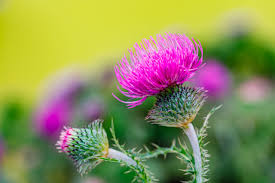Introduction
Thistle Weed, Thistle weed, commonly known for its sharp spines and prickly leaves, is often considered a nuisance by gardeners and farmers alike. However, understanding its characteristics and potential benefits can lead to more informed management practices. This article delves into the nature of thistle weeds, how to control them, and their surprising advantages in certain contexts.
What is Thistle Weed?
Thistle weeds belong to the Asteraceae family and are characterized by their spiky leaves and purple flowers. There are several species of thistles, with the most notorious being Canada thistle (Cirsium arvense) and bull thistle (Cirsium vulgare). These plants thrive in disturbed soils and are often found in fields, roadsides, and gardens.
Characteristics of Thistle Weed
- Growth Habit: Thistles can grow up to 5 feet tall, with some species spreading rapidly through both seeds and root systems. Their leaves are often lobed and covered with fine hairs, which contribute to their prickly texture.
- Flowers and Seeds: Thistle flowers are usually purple or pink and bloom from late spring to early fall. Each flower can produce hundreds of seeds that are easily dispersed by wind, making thistle weeds particularly invasive.
- Root System: Many thistles have extensive root systems that allow them to outcompete other plants for nutrients and water. This resilience makes them challenging to control.
Controlling Thistle Weeds
While thistle weeds can be problematic, several effective control methods can help manage their spread:
- Cultural Practices: Maintaining healthy soil and promoting competition from desirable plants can suppress thistle growth. Regular mowing before seed production can also prevent them from spreading.
- Mechanical Control: Hand-pulling thistles can be effective if done before they flower. However, care must be taken to remove the entire root system to prevent regrowth.
- Chemical Control: Herbicides can be used to manage thistle populations. Systemic herbicides that target broadleaf plants are most effective, but care should be taken to follow application guidelines to minimize damage to surrounding plants.
- Biological Control: Certain insects, such as the thistle seed weevil (Rhinocyllus conicus), can help control thistle populations by feeding on their seeds.
Benefits of Thistle Weeds
Despite their reputation, thistle weeds can offer several benefits:
- Wildlife Habitat: Thistle flowers provide nectar for pollinators, including bees and butterflies. Their dense growth also offers shelter for small animals.
- Soil Health: Thistles can help prevent soil erosion and improve soil health by adding organic matter when they decompose.
- Medicinal Uses: Some thistle species, like milk thistle (Silybum marianum), are valued for their medicinal properties. Milk thistle is known for its liver-protective effects and is used in herbal remedies.
Conclusion
While thistle weeds can be a challenge for gardeners and farmers, understanding their characteristics and control methods can lead to more effective management strategies. Additionally, recognizing their potential benefits can shift the perspective on these often-misunderstood plants. By balancing control and appreciation, we can create a more harmonious relationship with nature.
You Might Also Like These:



